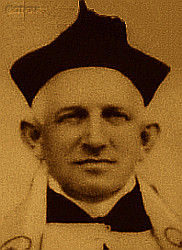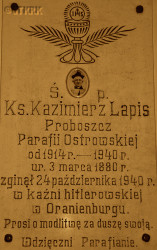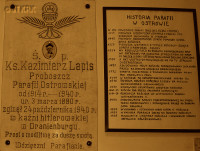Roman Catholic
St Sigismund parish
05-507 Słomczyn
85 Wiślana Str.
Konstancin deanery
Warsaw archdiocese, Poland
full list:
displayClick to display full list

searchClick to search full list by categories
wyświetlKliknij by wyświetlić pełną listę po polsku

szukajKliknij by przeszukać listę wg kategorii po polsku

Martyrology of the clergy — Poland
XX century (1914 – 1989)
personal data
surname
LAPIS
forename(s)
Casimir (pl. Kazimierz)
function
diocesan priest
creed
Latin (Roman Catholic) Church RCmore on
en.wikipedia.org
[access: 2014.09.21]
diocese / province
Gniezno and Poznań archdiocese (aeque principaliter)more on
www.archpoznan.pl
[access: 2012.11.23]
date and place
of death
17.11.1940

KL Sachsenhausenconcentration camp
today: Sachsenhausen‐Oranienburg, Oberhavel dist., Brandenburg state, Germany
more on
en.wikipedia.org
[access: 2018.11.18]
alt. dates and places
of death
24.10.1940,18.11.1940
details of death
After German invasion of Poland in 09.1939 and start of the World War II, after start of German occupation, arrested by the Germans on 08.11.1939.
Held in Strzelno gaol.
Released after 10 days.
On 26.08.1940 arrested again.
Through Strzelno taken to DL Scheglin transit camp in Szczeglin.
Finally on 29.08.1940 transported to KL Sachsenhausen concentration camp where perished.
According to the death certificate in the books of the Germ. Standesamt (Eng. registry office) in Oranienburg, No. 3994/40, the „honest” otherwise German „medical doctors” and formalists — and at the same time, unrivaled fairy tale spinners — noted that the cause of death was Germ. „Lobärpneumonie. Akute Herzschwäche” (Eng. „Lobar pneumonia. Acute heart failure”).
prisoner camp's numbers
30008Click to display source page (KL SachsenhausenClick to display the description)
cause of death
murder
perpetrators
Germans
sites and events
KL SachsenhausenClick to display the description, DL ScheglinClick to display the description, 26.08.1940 arrests (Warthegau)Click to display the description, Reichsgau WarthelandClick to display the description, «Intelligenzaktion»Click to display the description, Ribbentrop‐MolotovClick to display the description, Pius XI's encyclicalsClick to display the description
date and place
of birth
02.11.1880Birth certification on:
www.genealogiawarchiwach.pl
[access: 2025.09.08]

Barcintoday: Barcin gm., Żnin pov., Kuyavia‐Pomerania voiv., Poland
more on
en.wikipedia.org
[access: 2021.12.18]
parents
LAPIS Francis
🞲 ?, ? — 🕆 ?, ?

BŁACHOWSKA Rosalie
🞲 ?, ? — 🕆 ?, ?
presbyter (holy orders)
ordination
09.02.1908

Gnieznotoday: Gniezno urban gm., Gniezno pov., Greater Poland voiv., Poland
more on
en.wikipedia.org
[access: 2021.12.18]
Assumption of the Blessed Virgin Mary RC archcathedral churchmore on
en.wikipedia.org
[access: 2025.03.14]
positions held
1914 – 1940
parish priest — Ostrowotoday: Strzelno gm., Mogilno pov., Kuyavia‐Pomerania voiv., Poland
more on
en.wikipedia.org
[access: 2021.12.18] ⋄ Sacred Heart of Jesus RC parish ⋄ Kruszwicatoday: Kruszwica gm., Inowrocław pov., Kuyavia‐Pomerania voiv., Poland
more on
en.wikipedia.org
[access: 2021.07.18] RC deanery
1910 – 1914
vicar — Kościelecalso: Kościelec Kujawski
today: Pakość gm., Inowrocław pov., Kuyavia‐Pomerania voiv., Poland
more on
en.wikipedia.org
[access: 2020.11.01] ⋄ St Margaret the Virgin and Martyr RC parish ⋄ Inowrocławtoday: Inowrocław gm., Inowrocław pov., Kuyavia‐Pomerania voiv., Poland
more on
en.wikipedia.org
[access: 2021.07.18] RC deanery
1909 – 1910
vicar — Ostrowotoday: Gniewkowo gm., Inowrocław pov., Kuyavia‐Pomerania voiv., Poland
more on
en.wikipedia.org
[access: 2021.12.18] ⋄ Our Lady of the Scapular RC parish ⋄ Gniewkowotoday: Gniewkowo gm., Inowrocław pov., Kuyavia‐Pomerania voiv., Poland
more on
en.wikipedia.org
[access: 2020.11.27] RC deanery
vicar — Kobiernotoday: Krotoszyn gm., Krotoszyn pov., Greater Poland voiv., Poland
more on
en.wikipedia.org
[access: 2021.07.18] ⋄ St Adalbert the Bishop and Martyr RC parish ⋄ Krotoszyntoday: Krotoszyn gm., Krotoszyn pov., Greater Poland voiv., Poland
more on
en.wikipedia.org
[access: 2021.07.18] RC deanery
1908 – 1909
vicar — Popowo Kościelnetoday: Mieścisko gm., Wągrowiec pov., Greater Poland voiv., Poland
more on
en.wikipedia.org
[access: 2021.12.18] ⋄ Annunciation to the Blessed Virgin Mary RC parish ⋄ Gniezno St Peter and St Pauldeanery name
today: Gniezno urban gm., Gniezno pov., Greater Poland voiv., Poland
more on
en.wikipedia.org
[access: 2021.12.18] RC deanery
till 1908
student — Gnieznotoday: Gniezno urban gm., Gniezno pov., Greater Poland voiv., Poland
more on
en.wikipedia.org
[access: 2021.12.18] ⋄ philosophy and theology, Archbishop's Practical Theological Seminary (Lat. Seminarium Clericorum Practicum)
student — Poznańtoday: Poznań city pov., Greater Poland voiv., Poland
more on
en.wikipedia.org
[access: 2021.07.18] ⋄ philosophy and theology, Archbishop's Theological Seminary (Collegium Leoninum)
others related
in death
ADAMCZYKClick to display biography Stanislav, BRZĄKAŁAClick to display biography Victor, BURCZYKClick to display biography Felix, BYTOFClick to display biography Peter, CHARSZEWSKIClick to display biography Paulinus Ignatius, CHYLARECKIClick to display biography Stanislav, CIEMNIAKClick to display biography Louis, CYBULSKIClick to display biography Stanislav, CZAKIClick to display biography Saturnin, CZAPIEWSKIClick to display biography Joseph Leonard, DEMSKIClick to display biography Vladislav, DOERINGClick to display biography Alexander, FIGATClick to display biography Henry, GOŃCZClick to display biography Bernard Ambrose, GORALClick to display biography Vladislav, GRZEBIELEWSKIClick to display biography Joseph, GUZClick to display biography Joseph Adalbert (Fr Innocent), HEVELKEClick to display biography Alexander Eugene John Oscar, HINZClick to display biography Francis Felix, HINZClick to display biography Thaddeus, JARZĘBSKIClick to display biography Stanislav Romualdo, JORDANClick to display biography Boleslav, KALINOWSKIClick to display biography Theodore, KARAMUCKIClick to display biography Edmund Leo, KARCZYŃSKIClick to display biography Cyril Methodius, KAŹMIERCZAKClick to display biography Bronislav Anthony, KLEINClick to display biography John Matthias, KOMPFClick to display biography January Sigismund, KONKOLEWSKIClick to display biography Joachim, KOWNACKIClick to display biography Bronislav, KOZUBEKClick to display biography Roman, KRAUZEClick to display biography Edmund, KRUPIŃSKIClick to display biography Louis, KUBIAKClick to display biography John (Bro. Norbert Mary), KUBICKIClick to display biography Steven Adam Marian, KUBISTAClick to display biography Stanislav, KUPILASClick to display biography Francis, LENARTClick to display biography John, LICZNERSKIClick to display biography Constantine John, ŁOSIŃSKIClick to display biography Bernard Anthony, MACIĄTEKClick to display biography Stanislav Paul, MARCHLEWSKIClick to display biography Leonard, MATUSZEWSKIClick to display biography Francis Adam, MĄKOWSKIClick to display biography John, MĘŻNICKIClick to display biography Joseph, MICHNOWSKIClick to display biography Marian John, MITRĘGAClick to display biography Francis, MORKOWSKIClick to display biography Edmund, MOŚCICKIClick to display biography Joseph, NAGÓRSKIClick to display biography Paul Adalbert, NITSCHMANNClick to display biography Adam Robert, NOWAŃSKIClick to display biography Anthony, NOWICKIClick to display biography Alexander, OCHOŃSKIClick to display biography Charles Joseph (Fr Chris), OKOŁO–KUŁAKClick to display biography Anthony, PALUCHOWSKIClick to display biography Boleslav, PETRYKOWSKIClick to display biography Steven, PIASZCZYŃSKIClick to display biography Michael, PODLASZEWSKIClick to display biography Francis, POMIANOWSKIClick to display biography Vladislav, RADTKEClick to display biography Steven Boleslav, SĄSAŁAClick to display biography Theodore, SKOBLEWSKIClick to display biography Mieczyslav, SKOWRONClick to display biography Casimir, SOCHACZEWSKIClick to display biography Bronislav Peter, SWINARSKI–PORAJClick to display biography Nicholas Ignatius Bogusław, SYNOWIECClick to display biography Boleslav, SZUKALSKIClick to display biography John Wladysław, SZYMAŃSKIClick to display biography Bruno Peter John, ŚLEDZIŃSKIClick to display biography Joseph Marian, TUSZYŃSKIClick to display biography Joseph, TYMIŃSKIClick to display biography Anthony, WAWRZYNOWICZClick to display biography John, WĄSOWICZClick to display biography Sigismund, WIERZBICKIClick to display biography Sigismund Lawrence, WIERZCHOWSKIClick to display biography Fabian Sebastian, WILLIMSKYClick to display biography Albert, WŁODARCZYKClick to display biography Ignatius, WOHLFEILClick to display biography Robert, WRÓBLEWSKIClick to display biography Bronislav, ZAWISZAClick to display biography Valentine, ZIELIŃSKIClick to display biography Paul Nicholas, ZIEMSKIClick to display biography Alexander Felix, ZIENKOWSKIClick to display biography Vaclav, ŻUCHOWSKIClick to display biography Vaclav
sites and events
descriptions
KL Sachsenhausen: In Germ. Konzentrationslager (Eng. concentration camp) KL Sachsenhausen, set up in the former Olympic village in 07.1936, hundreds of Polish priests were held in 1940, before being transported to KL Dachau. Some of them perished in KL Sachsenhausen. Murderous medical experiments on prisoners were carried out in the camp. In 1942‐1944 c. 140 prisoners slaved at manufacturing false British pounds, passports, visas, stamps and other documents. Other prisoners also had to do slave work, for Heinkel aircraft manufacturer, AEG and Siemens among others. On average c. 50,000 prisoners were held at any time. Altogether more than 200,000 inmates were in jailed in KL Sachsenhausen and its branched, out of which tens of thousands perished. Prior to Russian arrival mass evacuation was ordered by the Germans and c. 80,000 prisoners were marched west in so‐called „death marches” to other camps, i.e. KL Mauthausen‐Gusen and KL Bergen‐Belsen. The camp got liberated on 22.04.1945. After end of armed hostilities Germans set up there secret camp for German prisoners and „suspicious” Russian soldiers. (more on: en.wikipedia.orgClick to attempt to display webpage
[access: 2018.11.18])
DL Scheglin: Germ. Durchgangslager Scheglin (Eng. Transit Camp) — German camp in Szczeglin n. Mogilno, operational from 01.10.1939 till 15.09.1940. Germans kept there c. 4,600 Poles, forcing them to perform slave labour — before transporting them to concentration camps. Among others on 29.08.1940 Germans sent from DL Scheglin 188 Polish priests to KL Sachsenhausen concentration camp. Approx. 150 of those held in DL Scheglin were murdered — some in the camp itself, the others in an execution site in Świerkowice forest. (more on: www.dsh.waw.plClick to attempt to display webpage
[access: 2013.06.23])
26.08.1940 arrests (Warthegau): As part of the Germ. „Ohne Gott, ohne Religion, ohne Priesters und Sakramenten” (Eng. „without God, without religion, without priest and sacrament”) policy, formulated by the Germ. Gauleiter (Eng. district head), Arthur Greiser, in the German province Germ. Reichsgau Wartheland (Eng. Wartheland Reichs District), organized by the Germans in the occupied part of Poland known as Greater Poland, hundreds of Polish priests were arrested on this day. Herded, together with priests arrested previously and held in IL Lond internment camp in Ląd on Warta river camp, among others, in DL Scheglin transit camp in Szczeglin n. Mogilno. Three days later all were transferred to KL Sachsenhausen concentration camp.
Reichsgau Wartheland: After the Polish defeat in the 09.1939 campaign, which was the result of the Ribbentrop‐Molotov Pact and constituted the first stage of World War II, and the beginning of German occupation in part of Poland (in the other, eastern part of Poland, the Russian occupation began), the Germans divided the occupied Polish territory into five main regions (and a few smaller). The largest one was transformed into Germ. Generalgouvernement (Eng. General Governorate), intended exclusively for Poles and Jews and constituting part of the so‐called Germ. Großdeutschland (Eng. Greater Germany). Two were added to existing German provinces. From two other separate new provinces were created. Greater Poland region was one of them, incorporated into Germany on 08.10.1939, by decree of the German leader Adolf Hitler (formally came into force on 26.10.1939), and on 24.01.1940 transformed into the Germ. Reichsgau Wartheland (Eng. Wartheland Reich Province), in which the law of the German state was to apply. The main axis of the policy of the new province, the territory of which the Germans recognized as the Germ. „Ursprünglich Deutsche” (Eng. „natively German”), despite the fact that 90% of its inhabitants were Poles, was Germ. „Entpolonisierung” (Eng. „Depolonisation”), i.e. forced Germanization. C. 100,000 Poles were murdered as part of the Germ. „Intelligenzaktion”, i.e. extermination of Polish intelligentsia and ruling classes. C. 630,000 were forcibly resettled to the Germ. Generalgouvernement, and their place taken by the Germans brought from other areas occupied by Germany (e.g. the Baltic countries, Bessarabia, Bukovina, etc.). Poles were forced to sign the German nationality list, the Germ. Deutsche Volksliste DVL. As part of the policy of „Ohne Gott, ohne Religion, ohne Priesters und Sakramenten” (Eng. „No God, no religion, no priest or sacrament”) most Catholic priests were arrested and sent to concentration camps. All schools teaching in Polish, Polish libraries, theaters and museums were closed. Polish landed estates confiscated. To further reduce the number of the Polish population, Poles were sent to forced labor deep inside Germany, and the legal age of marriage for Poles was increased (25 for women, 28 for men). The German state office, Germ. Rasse‐ und Siedlungshauptamt (Eng. Main Office of Race and Settlement) RuSHA, under the majesty of German law, abducted several thousand children who met specific racial criteria from Polish families and subjected them to forced Germanization, handing them over to German families. After the end of hostilities of World War II, the overseer of this province, the Germ. Reichsstatthalter (Eng. Reich Governor) and the Germ. Gauleiter (Eng. district head) of the German National Socialist Party, Arthur Karl Greiser, was executed. (more on: en.wikipedia.orgClick to attempt to display webpage
[access: 2024.06.21])
«Intelligenzaktion»: German: «Intelligenzaktion» (English: „Intelligence Action”) — a German program of extermination of the Polish elite, mainly the intelligentsia and leadership layers, carried out from the beginning of the occupation in w 09.1939 to 04.1940, mainly in territories directly annexed to Germany, but also in the so‐called Germ. Generalgouvernement (Eng. General Governorate), where it was called «AB‐aktion». In the first phase, immediately after the beginning of the German occupation, during military operations carried out by the Germ. Wehrmacht (Eng. Armed Forces) and the genocidal units of the Germ. Einsatzgruppen (Eng. Operational Groups) of the Germ. Sicherheitspolizei (Eng. Security Police), i.e. SiPo, and Germ. Sicherheitsdienst des Reichsführers SS (Eng. Security Service of the Reichsführer SS), i.e. SD, organized by the Germ. Reichssicherheitshauptamt (Eng. Reich Main Security Office), i.e. RSHA, which followed the troops, carried out under the Germ. Unternehmen „Tannenberg” (Eng. Operation „Tannenberg”) — based on the so‐called Germ. Sonderfahndungsliste (Eng. Special Wanted Lists), i.e. proscription lists of Poles considered particularly dangerous to the Third Reich, prepared by the Zentralstelle II/P (Polen) unit of the German RSHA. Later, implemented by the German civilian occupation authorities and the genocidal unit of the Germ. Volksdeutscher Selbstschutz (Eng. Ethnic Germans Self‐Defense), whose members were Germ. Volksdeutsche (Eng. Ethnic Germans), i.e. representatives of the German minority in Poland. According to various sources, these lists, at the beginning of 09.1939, could have contained the details of 61,000—88,000 „dangerous” Poles — although these figures cannot be confirmed. In total, during this genocide, c. 50,000 teachers, Catholic priests, representatives of the landed gentry, freelancers, social and political activists, and retired military personnel were systematically and methodically murdered. Another 50,000 were sent to concentration camps, where only a negligible percentage survived. (more on: en.wikipedia.orgClick to attempt to display webpage
[access: 2014.10.04])
Ribbentrop‐Molotov: Genocidal Russian‐German alliance pact between Russian leader Joseph Stalin and German leader Adolf Hitler signed on 23.08.1939 in Moscow by respective foreign ministers, Mr. Vyacheslav Molotov for Russia and Joachim von Ribbentrop for Germany. The pact sanctioned and was the direct cause of joint Russian and German invasion of Poland and the outbreak of the World War II in 09.1939. In a political sense, the pact was an attempt to restore the status quo ante before 1914, with one exception, namely the „commercial” exchange of the so‐called „Kingdom of Poland”, which in 1914 was part of the Russian Empire, fore Eastern Galicia (today's western Ukraine), in 1914 belonging to the Austro‐Hungarian Empire. Galicia, including Lviv, was to be taken over by the Russians, the „Kingdom of Poland” — under the name of the General Governorate — Germany. The resultant „war was one of the greatest calamities and dramas of humanity in history, for two atheistic and anti‐Christian ideologies — national and international socialism — rejected God and His fifth Decalogue commandment: Thou shall not kill!” (Abp Stanislav Gądecki, 01.09.2019). The decisions taken — backed up by the betrayal of the formal allies of Poland, France and Germany, which on 12.09.1939, at a joint conference in Abbeville, decided not to provide aid to attacked Poland and not to take military action against Germany (a clear breach of treaty obligations with Poland) — were on 28.09.1939 slightly altered and made more precise when a treaty on „German‐Russian boundaries and friendship” was agreed by the same murderous signatories. One of its findings was establishment of spheres of influence in Central and Eastern Europe and in consequence IV partition of Poland. In one of its secret annexes agreed, that: „the Signatories will not tolerate on its respective territories any Polish propaganda that affects the territory of the other Side. On their respective territories they will suppress all such propaganda and inform each other of the measures taken to accomplish it”. The agreements resulted in a series of meeting between two genocidal organization representing both sides — German Gestapo and Russian NKVD when coordination of efforts to exterminate Polish intelligentsia and Polish leading classes (in Germany called «Intelligenzaktion», in Russia took the form of Katyń massacres) where discussed. Resulted in deaths of hundreds of thousands of Polish intelligentsia, including thousands of priests presented here, and tens of millions of ordinary people,. The results of this Russian‐German pact lasted till 1989 and are still in evidence even today. (more on: en.wikipedia.orgClick to attempt to display webpage
[access: 2015.09.30])
Pius XI's encyclicals: Facing the creation of two totalitarian systems in Europe, which seemed to compete with each other, though there were more similarities than contradictions between them, Pope Pius XI issued in 03.1937 (within 5 days) two encyclicals. In the „Mit brennender Sorge” (Eng. „With Burning Concern”) published on 14.03.1938, condemned the national socialism prevailing in Germany. The Pope wrote: „Whoever, following the old Germanic‐pre‐Christian beliefs, puts various impersonal fate in the place of a personal God, denies the wisdom of God and Providence […], whoever exalts earthly values: race or nation, or state, or state system, representatives of state power or other fundamental values of human society, […] and makes them the highest standard of all values, including religious ones, and idolizes them, this one […] is far from true faith in God and from a worldview corresponding to such faith”. On 19.03.1937, published „Divini Redemptoris” (Eng. „Divine Redeemer”), in which criticized Russian communism, dialectical materialism and the class struggle theory. The Pope wrote: „Communism deprives man of freedom, and therefore the spiritual basis of all life norms. It deprives the human person of all his dignity and any moral support with which he could resist the onslaught of blind passions […] This is the new gospel that Bolshevik and godless communism preaches as a message of salvation and redemption of humanity”… Pius XI demanded that the established human law be subjected to the natural law of God , recommended the implementation of the ideal of a Christian state and society, and called on Catholics to resist. Two years later, National Socialist Germany and Communist Russia came together and started World War II. (more on: www.vatican.vaClick to attempt to display webpage
[access: 2023.05.28], www.vatican.vaClick to attempt to display webpage
[access: 2023.05.28])
sources
personal:
www.wtg-gniazdo.orgClick to attempt to display webpage
[access: 2012.11.23], polacywberlinie.plClick to attempt to display webpage
[access: 2013.05.19], www.genealogiawarchiwach.plClick to attempt to display webpage
[access: 2025.09.08], www.faramogilno.plClick to attempt to display webpage
[access: 2012.11.23]
bibliographical:
„International Tracing Service (ITS), Bad Arolsen, GermanyClick to display source page”, Arolsen Archives
LETTER to CUSTODIAN/ADMINISTRATOR
If you have an Email client on your communicator/computer — such as Mozilla Thunderbird, Windows Mail or Microsoft Outlook, described at WikipediaPatrz:
en.wikipedia.org, among others — try the link below, please:
LETTER to CUSTODIAN/ADMINISTRATORClick and try to call your own Email client
If however you do not run such a client or the above link is not active please send an email to the Custodian/Administrator using your account — in your customary email/correspondence engine — at the following address:

giving the following as the subject:
MARTYROLOGY: LAPIS Casimir
To return to the biography press below:
 Click to return to biography
Click to return to biography












